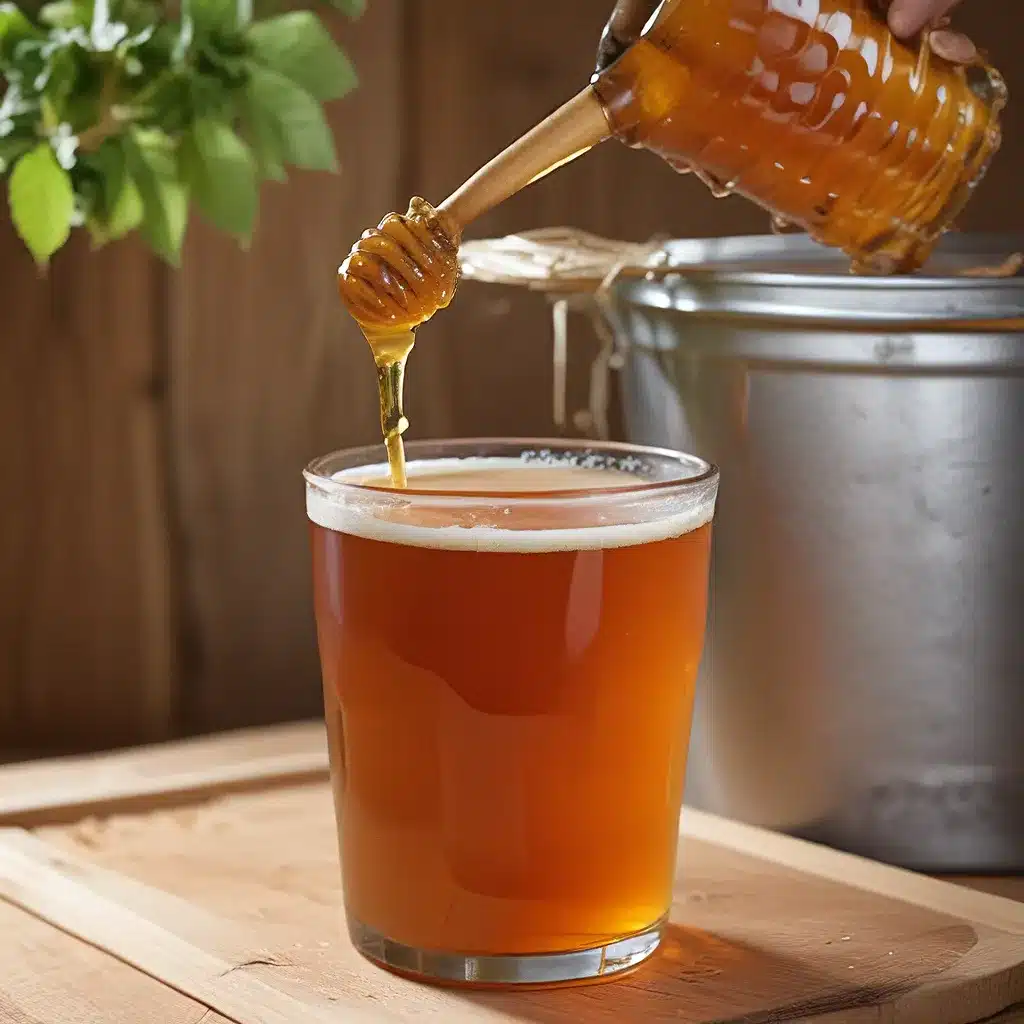
Ah, the sweet elixir of the gods – honey. This golden nectar, lovingly crafted by our buzzing little friends, has long held a special place in the hearts and minds of homebrewers. And let me tell you, when you harness the true potential of honey in your brews, the results can be nothing short of divine.
Uncovering the Honey Mystique
I’ll never forget the first time I cracked open a jar of raw, unfiltered honey and took a deep whiff. The complex floral aromas, the subtle undertones of caramel and spice – it was like I had been transported to a magical meadow, surrounded by the gentle hum of a thousand honeybees. From that moment on, I knew I had to explore the vast, untapped potential of this incredible ingredient.
As the Homebrewers Association notes, the dominant aspect of most meads and the primary fermentable sugar is honey, which is where the character of a straight honey mead will come from. But the fun doesn’t stop there – honey can also be the star player in a variety of other delightful brews, from fruity melomels to bold, spicy metheglin.
Sourcing the Good Stuff
Now, I know what you’re thinking – “But where do I find the perfect honey for my homebrewing adventures?” Fear not, my fellow mead-makers, for the answer lies in your local community. As the experts at Blue Sky Bee Supply advise, sourcing your honey locally is the way to go. Not only will you be supporting your community’s hardworking beekeepers, but you’ll also be able to tap into the unique flavors and aromas that come from your specific region.
Whether it’s the floral notes of orange blossom, the earthy richness of wildflower, or the bold, assertive character of buckwheat, the honey you choose can make all the difference in your brews. And let’s not forget about the crystallized stuff – according to the Homebrewers Association, that’s perfectly fine for mead making, too.
The Art of Blending
But the fun doesn’t stop there, my friends. You see, honey can be the perfect complement to a wide array of other ingredients, allowing you to create truly unique and captivating brews. Take, for instance, the humble melomels – meads blended with the sweet, juicy essence of fruits.
As the Homebrewers Association suggests, the addition of fruit can provide a whole new world of flavors and aromas, not to mention essential nutrients to aid in the fermentation process. Whether you’re experimenting with the tart bite of raspberries, the tropical allure of mangoes, or the rich, jammy notes of blackberries, the possibilities are truly endless.
And let’s not forget about the regal pyment – a marriage of honey and grape juice that can yield a truly transcendent elixir. The Homebrewers Association advises that you can either blend the grape juice and honey, or simply add the honey directly to the juice, adjusting the gravity as needed. The result? A harmonious balance of sweetness, acidity, and that oh-so-satisfying wine-like complexity.
Mastering the Mead-Making Process
Now, I know what you’re thinking – “But how do I actually make this stuff?” Well, my friends, let me walk you through the sweet, sweet steps.
As the Homebrewers Association outlines, the key is to start with a large, open-top fermenter, like a plastic bucket, to allow for ample headspace and oxygen exposure during the initial stages of fermentation. Add your honey, slowly incorporate your water (or fruit juice, if you’re going the melomels route), and check your gravity to ensure you’ve hit your target.
Now, the real magic happens with the yeast. The experts recommend dried yeast strains like Lalvin 71B-1122 or D-47, which can handle the high-sugar environment of mead-making with aplomb. But don’t forget the all-important nutrients – honey may be sweet, but it’s notoriously lacking in the essential vitamins and minerals that yeast need to thrive.
And the secret weapon? Staggered nutrient additions. As the Homebrewers Association advises, a combination of diammonium phosphate (DAP) and Fermaid K, added in small increments throughout the fermentation process, can help keep your yeast happy, healthy, and churning out those delightful mead-y flavors.
The Joys of Aging and Finishing
Now, I know what you’re thinking – “But what about the aging process? Isn’t mead supposed to take, like, a decade to reach its full potential?” Well, my friends, the times, they are a-changin’. As the Homebrewers Association explains, innovative techniques borrowed from the commercial winemaking world have allowed mead-makers to produce truly exceptional brews in a fraction of the time.
Sure, a little bit of patience is still required, but with the right approach, you can have your mead sparkling clear and ready to enjoy in a matter of weeks or months, not years. And let’s not forget about the fun of fine-tuning the final touches – whether that means back-sweetening with a touch of honey, balancing the acidity with a splash of citrus, or adding a hint of spice to really make those flavors sing.
And let’s not forget about that all-important carbonation. The Homebrewers Association notes that these days, they prefer the force-carbonation route, as bottle-conditioning can be a tricky proposition, especially for meads that have already reached their alcohol limit.
Embracing the Sweet, Sweet Future
So, there you have it, my fellow mead-makers – the secrets to unlocking the true potential of honey in your homebrewing adventures. From sourcing the perfect local nectar to mastering the art of blending and aging, the world of honey-infused brews is truly a never-ending source of delicious discovery.
And who knows, maybe your next creation will be the talk of the town down at The Up & Under Pub – a hub for all the local beer and mead enthusiasts. So, what are you waiting for? Get out there, get your hands dirty, and start crafting those sweet, sweet masterpieces. Cheers, my friends!

